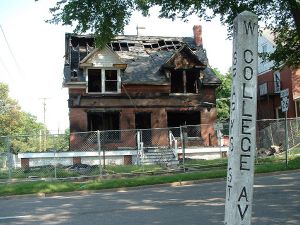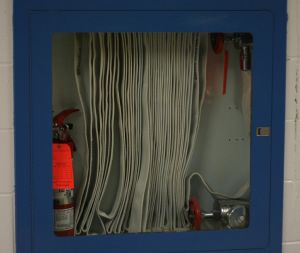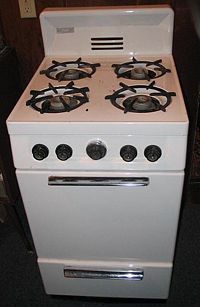Fire Safety
 From Nwe
From Nwe 
Fire safety refers to precautions that are taken to prevent or reduce the likelihood of a fire that may result in death, injury, or property damage, alert those in a structure to the presence of a fire in the event one occurs, better enable those threatened by a fire to survive, or to reduce the damage caused by a fire. Fire safety measures include those that are planned during the construction of a building or implemented in structures that are already standing, and those that are taught to occupants of the building.
Threats to fire safety are referred to as fire hazards. A fire hazard may include a situation that increases the likelihood a fire may start or may impede escape in the event a fire occurs.
Fire safety is often a component of building safety. Those who inspect buildings for violations of the Fire Code and go into schools to educate children on Fire Safety topics are fire department members known as fire prevention officers. The Chief Fire Prevention Officer or Chief of Fire Prevention will normally train newcomers to the Fire Prevention Division and may also conduct inspections or make presentations.

Key elements
- Building a facility in accordance with the version of the local building code in effect at the time of building permit application.
- Maintaining a facility and conducting oneself in accordance with the provisions of the fire code, after the building is occupied. This is based on knowledge of the code by the owner and ensuring that the occupants and operators of the building are aware of the currently applicable regulations. Examples of such include, but are not limited to, the following:
- Not exceeding the maximum occupancy within any part of the building.
- Maintaining proper fire exits and proper exit signage (e.g., exit signs pointing to them that can function in a power failure).
- Placing and maintaining fire extinguishers in easily accessible places.
- Properly storing/using, hazardous materials that may be needed inside the building for storage or operational requirements (such as solvents in spray booths).
- Prohibiting flammable materials in certain areas of the facility.
- Periodically inspecting buildings for violations, issuing Orders To Comply and, potentially, prosecuting or closing buildings that are not in compliance, until the deficiencies are corrected or condemning it in extreme cases.
- Maintaining fire alarm systems for detection and warning of fire.
- Obtaining and maintaining a complete inventory of firestops.
- Ensuring that spray fireproofing remains undamaged.
- Maintaining a high level of training and awareness of occupants and users of the building to avoid obvious mistakes, such as the propping open of fire doors.
- Conduct fire drills at regular intervals throughout the year
Common fire hazards

Some common fire hazards are:
- Blocked cooling vent
- Overloaded electrical system
- Fuel store areas with high oxygen concentration or insufficient protection
- Materials that produce toxic fumes when heated
- Objects that block fire exits
- Clothes resting under a gas dryer
Fire code
The Fire code (also Fire prevention code or Fire safety code) is a model code adopted by the state or local jurisdiction and enforced by fire prevention officers within municipal fire departments. It is a set of rules prescribing minimum requirements to prevent fire and explosion hazards arising from storage, handling, or use of dangerous materials, or from other specific hazardous conditions. It complements the building code. The fire code is aimed primarily at preventing fires, ensuring that necessary training and equipment will be on hand, and that the original design basis of the building, including the basic plan set out by the architect, is not compromised. The fire code also addresses inspection and maintenance requirements of various fire protection equipment in order to maintain optimal active fire protection and passive fire protection measures.
A typical fire safety code includes administrative sections about the rule-making and enforcement process, and substantive sections dealing with fire suppression equipment, particular hazards such as containers and transportation for combustible materials, and specific rules for hazardous occupancies, industrial processes, and exhibitions.
Sections may establish the requirements for obtaining permits and specific precautions required to remain in compliance with a permit. For example, a fireworks exhibition may require an application to be filed by a licensed pyrotechnician, providing the information necessary for the issuing authority to determine whether safety requirements can be met. Once a permit is issued, the same authority (or another delegated authority) may inspect the site and monitor safety during the exhibition, with the power to halt operations, when unapproved practices are seen or when unforeseen hazards arise.
List of some typical fire and explosion issues in a fire code
- fireworks, explosives, mortars and cannons, model rockets (licenses for manufacture, storage, transportation, sale, use)
- certification for servicing, placement, and inspecting fire extinguishing equipment
- general storage and handling of flammable liquids, solids, gases (tanks, personnel training, markings, equipment)
- limitations on locations and quantities of flammables (e.g., ten liters of gasoline inside a residential dwelling)
- specific uses and specific flammables (e.g., dry cleaning, gasoline distribution, explosive dusts, pesticides, space heaters, plastics manufacturing)
- permits and limitations in various building occupancies (assembly hall, hospital, school, theatre, elderly care, prisons, warehouses, etc)
- locations that require a smoke detector, sprinkler system, fire extinguisher, or other specific equipment or procedures
- removal of interior and exterior obstructions to emergency exits or firefighters and removal of hazardous materials
- permits and limitations in special outdoor applications (tents, asphalt kettles, bonfires, etc.)
- other hazards (flammable decorations, welding, smoking, bulk matches, tire yards)
- Electrical safety code
- Fuel gas code
Fire safety education
Most fire departments have fire safety education programs. One function of Fire Prevention Officers is to visit schools to educate children in how to prevent fires and the actions they should take should a fire occur.
Fire prevention programs may include distribution of smoke detectors, visiting schools to review key topics with the students and implementing nationally recognized programs such as NFPAs "Risk Watch" and "Learn not to burn."[1]
Other programs or props can be purchased by fire departments or community organizations. These are usually entertaining and designed to capture children's attention and relay important messages. Props include those that are mostly auditory, such as puppets and robots. The prop is visually stimulating but the safety message is only transmitted orally. Other props are more elaborate, access more senses and increase the learning factor. They mix audio messages and visual queues with hands-on interaction. Examples of these include mobile trailer safety houses and tabletop hazard house simulators.
All programs tend to mix messages of general injury prevention, safety, fire prevention and escape in case of fire. In most cases the fire department representative is regarded as the expert and is expected to present information in a manner that is appropriate for each age group.
Target Audiences
In the United States, the very young and the elderly are considered to be "at risk" populations. These two groups represent approximately 33 percent of the population and are targeted to receive fire safety information.[2]
See also
- Construction
- Fire
- Fire alarm
- Smoke detector
Notes
- ↑ NFPA eLearning On-line catalog Retrieved February 1, 2009.
- ↑ Living independently and fire safety.
References
ISBN links support NWE through referral fees
- Bunker, Merton W. NFPA's Pocket Guide to Fire Alarm System Installation, 2nd ed. Sudbury, MA: Jones and Bartlett Publishers, Inc., 2006. ISBN 0763746053
- Gagnon, Robert. Design of Special Hazard & Fire Alarm Systems. Florence, KY: Thomson Delmar Learning, 1998. ISBN 0827382936
- Traister, John E. Security/Fire Alarm Systems: Design, Installation, and Maintenance, 2nd ed. Columbus, OH: McGraw-Hill, 1995. ISBN 0070652961
External links
All links retrieved April 10, 2017.
- Fire Safety for wheelchair users A fire safety guide for wheelchair users published by United Spinal Association
- Sample Fire Code Table of Contents from International Code Council
- Journal of Fire Protection Engineering for the latest research, methods and developments within Fire Protection Engineering
- moebuildingcontrol.co.uk - UK Guidance on fire safety codes and fire engineering
- Fireservice - Home Fire Safety Advice
Credits
New World Encyclopedia writers and editors rewrote and completed the Wikipedia article in accordance with New World Encyclopedia standards. This article abides by terms of the Creative Commons CC-by-sa 3.0 License (CC-by-sa), which may be used and disseminated with proper attribution. Credit is due under the terms of this license that can reference both the New World Encyclopedia contributors and the selfless volunteer contributors of the Wikimedia Foundation. To cite this article click here for a list of acceptable citing formats.The history of earlier contributions by wikipedians is accessible to researchers here:
- Fire safety history
The history of this article since it was imported to New World Encyclopedia:
- History of "Fire safety"
Note: Some restrictions may apply to use of individual images which are separately licensed.
↧ Download as ZWI file | Last modified: 02/04/2023 01:08:31 | 39 views
☰ Source: https://www.newworldencyclopedia.org/entry/Fire_safety | License: CC BY-SA 3.0
 ZWI signed:
ZWI signed: KSF
KSF